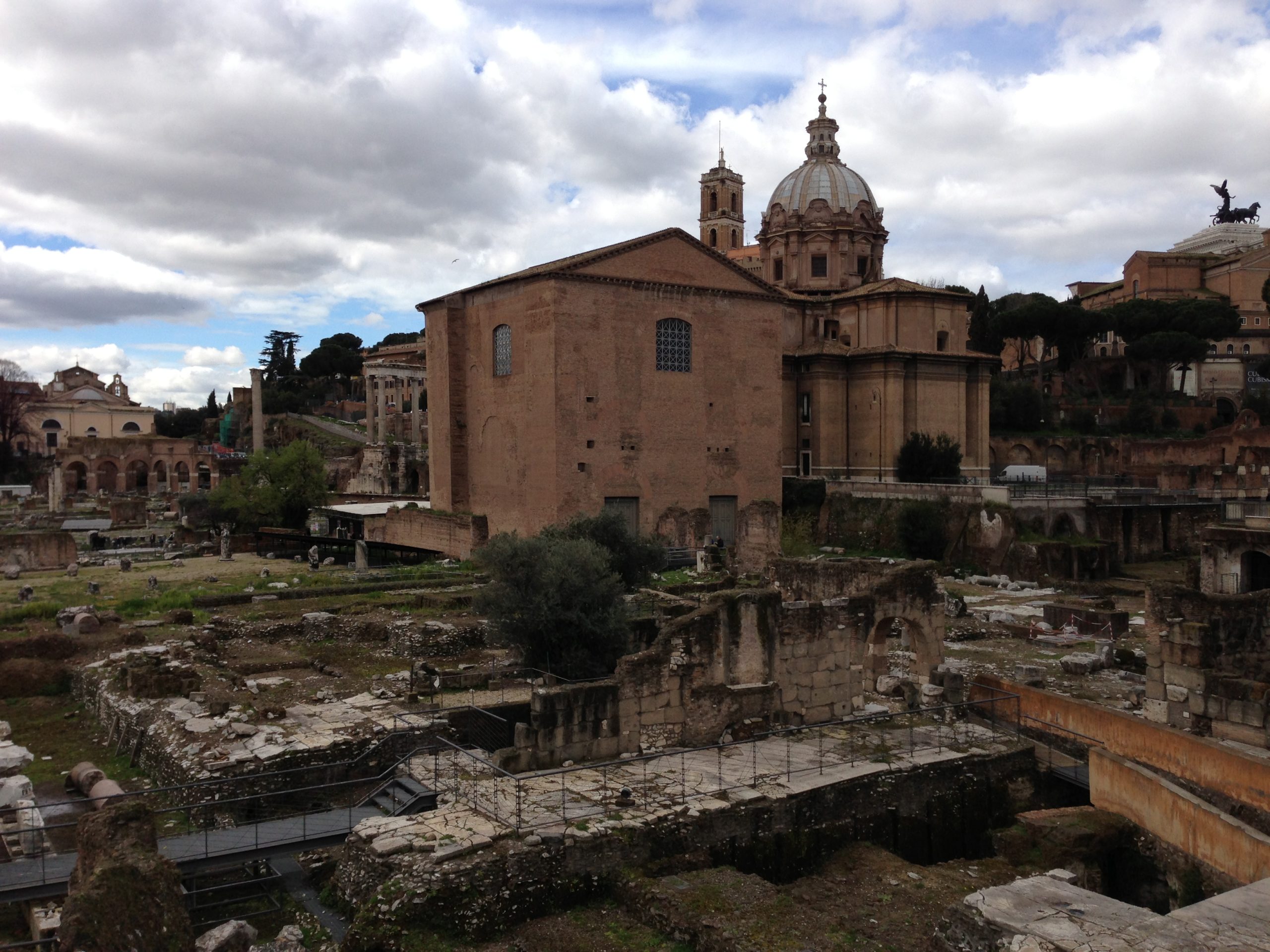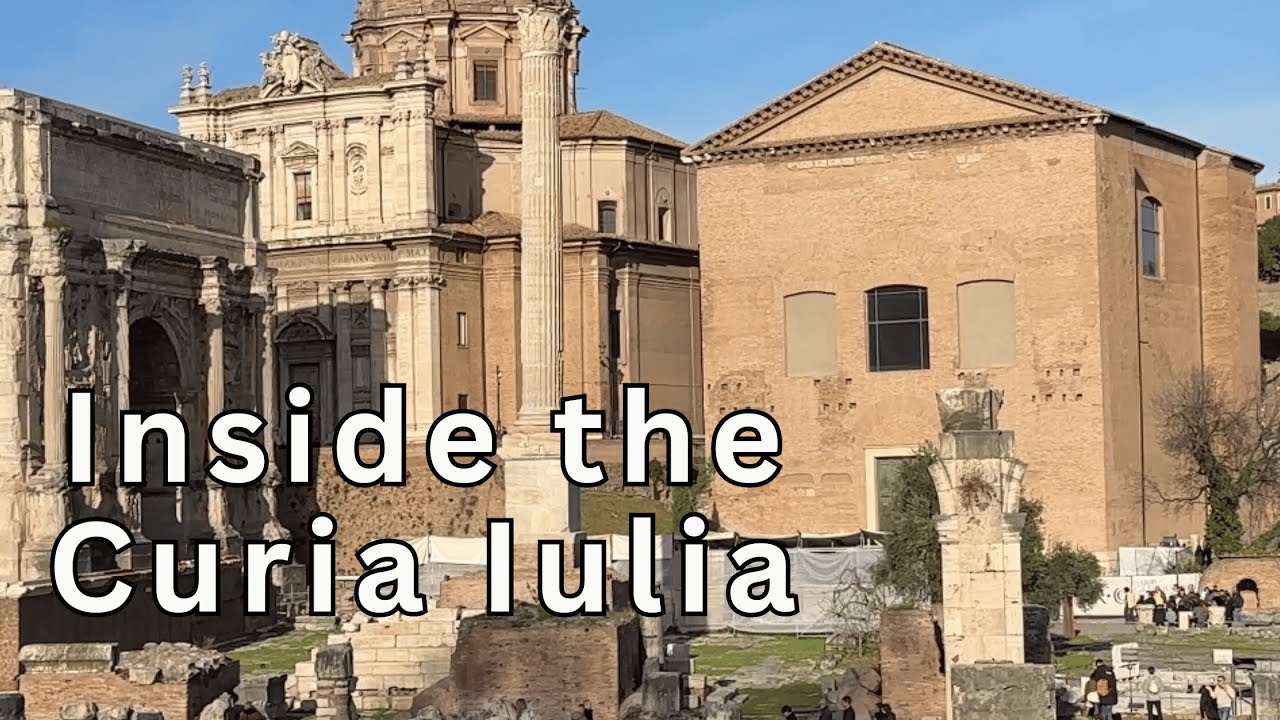The Curia Julia, located in the heart of the Roman Forum, is one of the best-preserved buildings from antiquity. Completed in 29 BCE under Augustus, it served as the meeting place of the Roman Senate. Over the centuries it was repurposed, first as a church in the Middle Ages and today as a museum and archaeological site.
The Curia Julia was not the first senate house in the Forum. The earliest, the Curia Hostilia, was built in the 7th century BCE by King Tullus Hostilius. It was later enlarged by the dictator Sulla in 80 BCE. This building witnessed famous moments in Roman history, including Cicero’s speeches against Catiline in 63 BCE. The Curia Hostilia was destroyed in 52 BCE, when supporters of the politician Publius Clodius Pulcher burned it down during his funeral.
In 44 BCE, Julius Caesar began constructing a new senate house. He did not live to see it completed, as he was assassinated on the Ides of March that same year. The building was finished by his heir, Augustus, in 29 BCE and named the Curia Julia in Caesar’s honor. While the Senate met here, by this time real power rested firmly with the emperor.
The Curia Julia featured a colonnaded porch, large bronze doors, and three high windows. Inside stood a gilded statue of Victoria, goddess of victory. The building remained in use until 283 CE, when it was destroyed in the fire of Carinus. It was rebuilt by Emperor Diocletian between 284 and 305 CE, and it is this version that we see in the Forum today.
In 630 CE, Pope Honorius I converted the Curia into the church of Sant’Adriano al Foro, dedicated to the Christian martyr Adrian of Nicomedia. During the Middle Ages, the building became a pilgrimage site. Its marble wall panels were reused as church altars, and in 1660 its bronze doors were moved to the Basilica of St. John Lateran.
In the 1930s, Benito Mussolini restored the Curia Julia as part of his campaign to link Fascist Italy with the grandeur of ancient Rome. He stripped away the church decorations and returned the building to its Roman appearance. Though done as propaganda, these works preserved the Curia and many of its original features. Today visitors can still see its restored late antique floor, fragments of marble wall veneer, Diocletian-era niches, and Byzantine frescoes.
Bibliography:
- Gardini, Ashley. (2023). “Fascist Architecture in Rome.” JSTOR Daily. https://daily.jstor.org/fascist-architecture-in-rome/
- Grout, James. “Curia.” University of Chicago. https://penelope.uchicago.edu/encyclopaedia_romana/romanforum/curia.html
- Grout, James. “Curia Julia: The Roman Senate House.” University of Chicago. https://penelope.uchicago.edu/encyclopaedia_romana/romanforum/curiajulia.html
- Platner, Samuel. (1929). “Curia Julia.” In A Topographical Dictionary of Ancient Rome (p.143-146). Retrieved from: https://penelope.uchicago.edu/Thayer/E/Gazetteer/Places/Europe/Italy/Lazio/Roma/Rome/_Texts/PLATOP*/Curia_Julia.html
The new senate house begun by Julius Caesar in 44 B.C. just before his assassination and continued by the triumvirs (Cass. Dio xliv. 5; xlv. 17 ; xlvii. 19). It was completed and dedicated in 29 B.C. by Augustus (Mon. Anc. iv. 1: curiam et continens ei chalcidicum feci; vi. 13; Suet. Calig. 60; Cass. Dio li. 22).
Read more:
Like its predecessor, the curia Hostilia, and the curia Pompeia, it was inaugurated as a templum (Varro ap. Gell. xiv. 7. 7). See also CIL vi. 877a (=32324), 1718, 32326 (Act. Lud. Saec. Sever. i. 5); s.c. de Mytilenaeis in Berl. Sitzber. 1889, 966. Augustus set up in it a statue of Victory (Dio li. 22 ; v. VICTORIA, ARA) and built an annex called the CHALCIDICUM (q.v.). The Secretarium Senatus, another annex of the senate house, probably also formed part of the structure of Augustus, though we have no direct evidence of its existence before the time of Diocletian.
The curia Iulia, like the older curia, was built in comitio (Plin. NH xxxv. 27, 131); in fact several senatus consulta which have come down to us in their Greek form state that they were voted ἐν κομετίῳ; one under Hadrian, however, is more explicit (in comitio in curia, EE ii. 273, 282).
The curia as restored by Augustus is believed by Hulsen (Neueste Ausgr. 12, fig. 7), who had previously (HC 51) connected them with the basilica Iulia, to be represented in coins of 29-27 B.C. (Cohen, Aug. 122; BM. Rep. ii. 16. 4358, 4359=Aug. 631, 632; cf. p. cxxiii, n. 4, where it is referred to the temple of Julius; while Richmond (JRS 1914, 218) wrongly refers it to a little shrine just outside the Atrium of Augustus on the Palatine). The statue of Victory standing on a globe which came from Tarentum is shown in the apex of the pediment, and is represented on other coins of the same date (BM Aug. 622-3; Cohen, Aug. 13; BM. Rep. ii. 14, 15. 4356-7, where it is wrongly stated to have been placed in the basilica Iulia).
Domitian restored the curia in 94 A.D. (Hieron. 161), and it was no doubt he who took the opportunity of dedicating the Chalcidicum to his patron goddess Minerva, whence it acquired the name of Atrium Minervae (Notit. Reg. VIII). This curia is represented in the famous Anaglypha Traiani (see ROSTRA). It is perhaps also represented in one of the reliefs of the arch of Benevento (Mitt. 1892, 257; SScR 194). The curia was burnt down in the fire of Carinus, and rebuilt by Diocletian (Chron. 148), and the existing building dates from his time.
We learn from sixteenth century drawings (Lanciani, Mem. L. 3. xi. 5-21 ; Mitt. 1895, 47-52) that it formed part of a group with the Atrium Minervae and the Secretarium Senatus.
The curia proper is a hall 25.20 metres by 17.61 metres, of brick-faced concrete, with a huge buttress at each angle; the lower part of the front wall was decorated with slabs of marble, while the upper part (like the exterior of the thermae of Caracalla and Diocletian) was covered with stucco in imitation of white marble blocks with heavily draughted joints. The travertine consoles and the brick cornice which they support (which are continued round the triangular pediment) were also coated with stucco. A flight of steps led up to the entrance door, to which belonged an epistyle bearing the inscription: [i]mperant[e… [n]eratius in… [c]uriam sen[atus]… The second line no doubt contained the name of an unknown praefectus urbi (fifth century). When the building became a church, a metrical (?) inscription was painted over it, of which only the first word, aspice, is preserved. Over the door were three large windows. A small portion of the pavement of the interior, of various coloured marbles, was recently exposed to view, but covered up again.
The marble facing of the internal walls was destroyed in 1562 (LR 266; LS iii. 221 (for details, see Archivio Boccapaduli Arm. ii. Mazzo iv. 46. 10). The brick facing of the exterior and the cornice were coated with stucco to represent marble (ib.), just as was the case in the Thermae of Diocletian.
In 303 A.D. there were erected in front of the curia, outside the comitium, two colossal columns, in celebration of the vicennalia and decennalia of Diocletian and his colleagues in the empire. The first base, found in 1490, is lost; but the second, decorated with inferior reliefs (one of which represents the suovetaurilia, in imitation of the Trajanic slabs) which was found in 1547, still lies not far from the niger lapis (Mitt. 1893, 281; HC 95-96; CIL vi. 1203-1205, 31261, 31262). For a glass cup commemorating the same vicennalia see BC 1882, 180-19o.
Near here are also fragments of a large base for a quadriga erected in honour of Arcadius and Honorius after Stilicho’s victory over Gildo in Africa in 398 A.D. (CIL vi. 1187, 31256 ; Mitt. 1895, 52-58 ; LR 261) and another inscription celebrating Stilicho’s victory over Radagaisus at Pollentia in 403 A.D. (CIL vi. 31987).
The church of S. Adriano was founded in the curia by Honorius I (625-638; LP lxxii. 6), who added the apse. It is called in tribus fatis from a group of the three fates which stood near the temple of Janus (Jord. i. 2. 259, 349; BCr 1912, 146; HC 24, 26; HCh 260-261). After this several bodies were buried in niches cut in the front wall, in the concrete core of the steps, and in front of them, on the pavement of the comitium. The doorway, 5.90 metres in height, probably remained in use until after the fire of Robert Guiscard the Norman in 1087, when its level was raised by 3.25 metres: and so it remained (with steps descending into the church from the higher ground outside) until the restoration of the church in 1654, when it was raised again by about the same amount. When the ancient bronze doors were removed to the Lateran by Borromini a few years later, various coins were found inside them, among which was one of Domitian. Between 1654 and the end of the nineteenth century there has been another rise in level of about 1 metre.
To the left of the curia was the CHALCIDICUM or Atrium Minervae (q.v.) (the last remains of which disappeared when the Via Bonella was made in 1585-90), a courtyard with a colonnade running down each side; while to the north-west again was the Secretarium Senatus, a hall measur- ing 18.17 by 8.92 metres, with an apse at the north-east end. An inscription shows that it had been restored by Junius Flavianus in 311 A.D. and that it was repaired in 412 A.D., after its destruction by fire, by the then Praefectus Urbi, Epifanius (CIL vi. 1718). The passage of Cassiodorus, Var. iv. 30, curvae porticus, quae iuxta domum palmatam (q.v.) posita, forum in modum areae decenter includit, etc., referred by Jord. i. 2. 257, 258 to the apse of this building, should more probably be taken to signify the south-western hemicycle of the forum of Trajan (BC 1887, 64-66; 1889,363; 1899, 88).
The ancient basilica of S. Martina, built in the ruins of the Secretarium Senatus, is first mentioned under Hadrian I (772-795; LP xcvii. 51, 96). It is called S. Martinae sita in tribus fatis under Leo III (LP xcviii. 90; HCh 381). It was restored by Pietro da Cortona in 1640 and its level raised, so that the older structure (in which no traces of antiquity are actually visible) serves as the crypt.
This content is brought to you by The American Institute for Roman Culture, a 501(C)3 US Non-Profit Organization.
Please support our mission to aid learning and understanding of ancient Rome through free-to-access content by donating today.
Cite This Page
Cite this page as: Darius Arya, The American Institute for Roman Culture, “Curia Iulia,” Ancient Rome Live. Last modified 08/25/2025. https://ancientromelive.org/curia-iulia/
License
Created by The American Institute of Roman Culture, published on 08/28/2021 under the following license: Creative Commons: Attribution-NonCommercial-ShareAlike. This license lets others remix, tweak, and build upon this content non-commercially, as long as they credit the author and license their new creations under the identical terms. Please note that content linked from this page may have different licensing terms.






